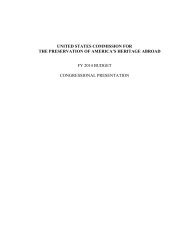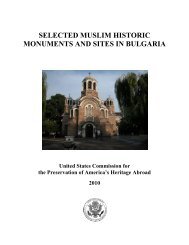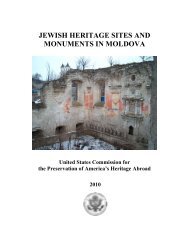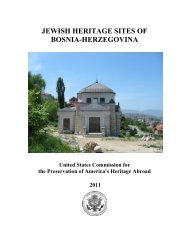jewish cemeteries, synagogues, and mass grave sites in ukraine
jewish cemeteries, synagogues, and mass grave sites in ukraine
jewish cemeteries, synagogues, and mass grave sites in ukraine
Create successful ePaper yourself
Turn your PDF publications into a flip-book with our unique Google optimized e-Paper software.
cemetery <strong>sites</strong>. Thus, many Jewish <strong>cemeteries</strong> were destroyed dur<strong>in</strong>g this period, <strong>and</strong> thous<strong>and</strong>s<br />
of Ukra<strong>in</strong>ians now live atop the <strong>grave</strong>s of generations of Jews.<br />
Cemeteries also became the <strong>sites</strong> of sport complexes, <strong>and</strong> more. In some cases, newly-made<br />
reservoirs <strong>and</strong> ponds flooded Jewish <strong>cemeteries</strong>. As for the places of <strong>mass</strong> execution of Jews, <strong>in</strong><br />
most cases they were not marked by any means or were not marked as Jewish <strong>mass</strong> burial <strong>sites</strong>,<br />
just as <strong>sites</strong> of “Soviet martyrs.” Only s<strong>in</strong>ce 1991, have places of <strong>mass</strong> execution of Jews begun<br />
to be marked, thanks mostly to f<strong>in</strong>ancial contributions from foreign <strong>in</strong>dividuals. At present,<br />
there are still too few of these places properly recognized.<br />
IV.3<br />
The Care for Jewish Sites <strong>in</strong> Independent Ukra<strong>in</strong>e<br />
S<strong>in</strong>ce 1991, there has been a gradual recognition of the identity of numerous Jewish <strong>sites</strong>. Full<br />
legal recognition of Jewish communal ownership of religious <strong>and</strong> other build<strong>in</strong>gs, as well as the<br />
establishment <strong>and</strong> recognition of the historic boundaries of <strong>cemeteries</strong> <strong>in</strong>volves, however,<br />
extensive research <strong>and</strong>, oftentimes, lengthy litigation. Even then, the f<strong>in</strong>al disposition of a<br />
property may have as much to do with the prestige <strong>and</strong> power of the current occupant or user as<br />
to any established legal claim. Thus, <strong>in</strong> many cities where there are established or newly revived<br />
Jewish communities, some properties have been returned for Jewish use. Most of these are<br />
former <strong>synagogues</strong> <strong>in</strong> need of costly repairs.<br />
International Jewish organizations, <strong>in</strong>clud<strong>in</strong>g the American Jewish Jo<strong>in</strong>t Distribution Committee,<br />
Agudath Israel, <strong>and</strong> the World Jewish Restitution Organization, have all played a role <strong>in</strong> this<br />
property restitution process. Smaller groups have also <strong>in</strong>tervened directly to assist Ukra<strong>in</strong>ian<br />
Jewish communities bear the cost of renovations. Early <strong>in</strong> the process, for example, the Jewish<br />
Community Relations Council of C<strong>in</strong>c<strong>in</strong>nati, Ohio (USA) jo<strong>in</strong>ed the Jewish Community of<br />
Kharkiv <strong>in</strong> their efforts to reclaim <strong>and</strong> restore the synagogue of that city. 46<br />
IV.3 (a) Cemeteries<br />
Unlike <strong>synagogues</strong>, the recovery <strong>and</strong> restoration of <strong>cemeteries</strong> has been much slower. The<br />
reason is that protection of these <strong>sites</strong> is not an urgent social need, although, it is a pious duty <strong>and</strong><br />
cultural obligation. Ma<strong>in</strong> <strong>cemeteries</strong> <strong>in</strong> communities that have Jewish <strong>in</strong>habitants are be<strong>in</strong>g<br />
nom<strong>in</strong>ally ma<strong>in</strong>ta<strong>in</strong>ed.<br />
The hundreds of <strong>cemeteries</strong> <strong>in</strong> more remote areas, especially western Ukra<strong>in</strong>e, where few Jews<br />
live, rema<strong>in</strong> <strong>in</strong> sorry condition. Of the 731 <strong>cemeteries</strong> visited as part of this survey, 60% have no<br />
wall, fence, or gate. A full 90%, have no sign <strong>in</strong>dicat<strong>in</strong>g their presence, <strong>in</strong>tended use, or history.<br />
For the most part, economic pressures for development rema<strong>in</strong> scant <strong>in</strong> these small agricultural<br />
centers, but there is always the risk of theft of stones for construction, or the open<strong>in</strong>g of new<br />
paths <strong>and</strong> roads across the grounds of <strong>cemeteries</strong> without walls or fences.<br />
As the data collected for this report demonstrates, the majority of Jewish <strong>cemeteries</strong> <strong>and</strong> <strong>mass</strong><br />
burial <strong>sites</strong> <strong>in</strong> Ukra<strong>in</strong>e are ab<strong>and</strong>oned <strong>and</strong> neglected. They lack clearly marked boundaries,<br />
46 For a full description of the process of communal property restitution <strong>in</strong> Ukra<strong>in</strong>e <strong>and</strong> other countries of the former<br />
Soviet Union, as well as of 49 <strong>synagogues</strong> returned for use by Ukra<strong>in</strong>e’s Jewish communities, <strong>in</strong> 2004, the M<strong>in</strong>istry<br />
of Foreign Affairs of Ukra<strong>in</strong>e published that 55 of 109 listed <strong>synagogues</strong> had been returned, see Michael Beizer,<br />
Our Legacy: The CIS Synagogues, Past <strong>and</strong> Present (Moscow <strong>and</strong> Jerusalem: Gesharim, 2002).<br />
42









